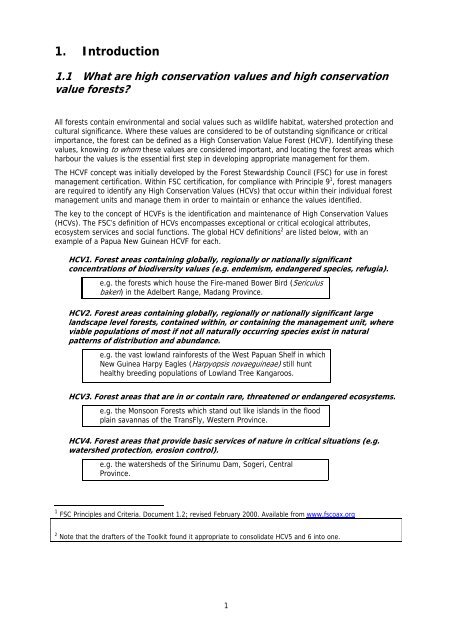A National Interpretation of the High Conservation Value Forest ...
A National Interpretation of the High Conservation Value Forest ...
A National Interpretation of the High Conservation Value Forest ...
You also want an ePaper? Increase the reach of your titles
YUMPU automatically turns print PDFs into web optimized ePapers that Google loves.
1. Introduction<br />
1.1 What are high conservation values and high conservation<br />
value forests?<br />
All forests contain environmental and social values such as wildlife habitat, watershed protection and<br />
cultural significance. Where <strong>the</strong>se values are considered to be <strong>of</strong> outstanding significance or critical<br />
importance, <strong>the</strong> forest can be defined as a <strong>High</strong> <strong>Conservation</strong> <strong>Value</strong> <strong>Forest</strong> (HCVF). Identifying <strong>the</strong>se<br />
values, knowing to whom <strong>the</strong>se values are considered important, and locating <strong>the</strong> forest areas which<br />
harbour <strong>the</strong> values is <strong>the</strong> essential first step in developing appropriate management for <strong>the</strong>m.<br />
The HCVF concept was initially developed by <strong>the</strong> <strong>Forest</strong> Stewardship Council (FSC) for use in forest<br />
management certification. Within FSC certification, for compliance with Principle 9 1 , forest managers<br />
are required to identify any <strong>High</strong> <strong>Conservation</strong> <strong>Value</strong>s (HCVs) that occur within <strong>the</strong>ir individual forest<br />
management units and manage <strong>the</strong>m in order to maintain or enhance <strong>the</strong> values identified.<br />
The key to <strong>the</strong> concept <strong>of</strong> HCVFs is <strong>the</strong> identification and maintenance <strong>of</strong> <strong>High</strong> <strong>Conservation</strong> <strong>Value</strong>s<br />
(HCVs). The FSC’s definition <strong>of</strong> HCVs encompasses exceptional or critical ecological attributes,<br />
ecosystem services and social functions. The global HCV definitions 2 are listed below, with an<br />
example <strong>of</strong> a Papua New Guinean HCVF for each.<br />
HCV1. <strong>Forest</strong> areas containing globally, regionally or nationally significant<br />
concentrations <strong>of</strong> biodiversity values (e.g. endemism, endangered species, refugia).<br />
e.g. <strong>the</strong> forests which house <strong>the</strong> Fire-maned Bower Bird (Sericulus<br />
bakeri) in <strong>the</strong> Adelbert Range, Madang Province.<br />
HCV2. <strong>Forest</strong> areas containing globally, regionally or nationally significant large<br />
landscape level forests, contained within, or containing <strong>the</strong> management unit, where<br />
viable populations <strong>of</strong> most if not all naturally occurring species exist in natural<br />
patterns <strong>of</strong> distribution and abundance.<br />
e.g. <strong>the</strong> vast lowland rainforests <strong>of</strong> <strong>the</strong> West Papuan Shelf in which<br />
New Guinea Harpy Eagles (Harpyopsis novaeguineae) still hunt<br />
healthy breeding populations <strong>of</strong> Lowland Tree Kangaroos.<br />
HCV3. <strong>Forest</strong> areas that are in or contain rare, threatened or endangered ecosystems.<br />
e.g. <strong>the</strong> Monsoon <strong>Forest</strong>s which stand out like islands in <strong>the</strong> flood<br />
plain savannas <strong>of</strong> <strong>the</strong> TransFly, Western Province.<br />
HCV4. <strong>Forest</strong> areas that provide basic services <strong>of</strong> nature in critical situations (e.g.<br />
watershed protection, erosion control).<br />
e.g. <strong>the</strong> watersheds <strong>of</strong> <strong>the</strong> Sirinumu Dam, Sogeri, Central<br />
Province.<br />
1 FSC Principles and Criteria. Document 1.2; revised February 2000. Available from www.fscoax.org<br />
2 Note that <strong>the</strong> drafters <strong>of</strong> <strong>the</strong> Toolkit found it appropriate to consolidate HCV5 and 6 into one.<br />
1

















